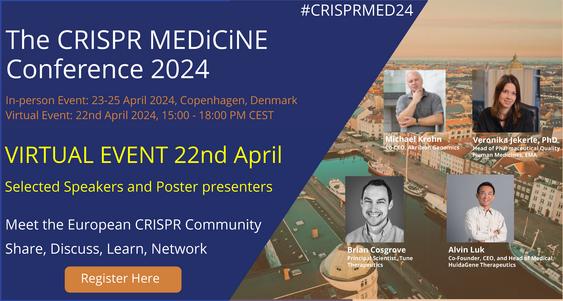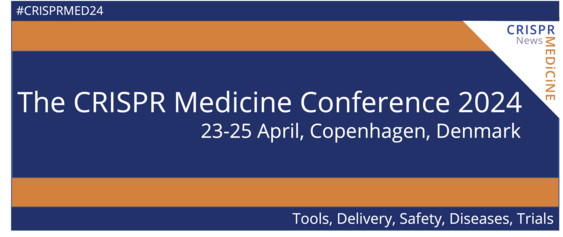CMN Weekly (13 May 2022) - Your Weekly CRISPR Medicine News
By: Karen O'Hanlon Cohrt - May. 13, 2022
Top picks
- Putting an End to Heart Attacks by Editing Human DNA. This writeup for Bloomberg discusses how Verve Therapeutics is targeting cholesterol-causing genes to clear arteries with its experimental base-editing therapy.
- Base editing marches on the clinic. As of this week, two companies have now received approval to initiate clinical trials for novel base-editing therapies. This writeup in Nature describes these therapeutic candidates, discusses the pros and cons of base editors, and gives an overview of pre-clinical-stage base-editing approaches to tackle human diseases.
Research
- Researchers in Switzerland and the U.S report a new CRISPR-based multiplex recording method, Record-seq, that enables the reconstruction of transcriptional histories of isogenic bacterial strains in vivo. By using barcoded CRISPR arrays, CRISPR-seq provides a scalable and non-invasive platform for interrogating intestinal and microbial physiology in the intestine without impacting host physiology. Record-seq can determine how single microbial genetic differences alter the way in which the microbe adapts to the host intestinal environment. The findings were published in Science today.
- Researchers in the U.S. and Israel recently described how they used CRISPR to sequentially introduce mutations into healthy human melanocytes in up to five genes that span six commonly disrupted melanoma pathways, forming nine genetically distinct cellular models of melanoma. Using this approach, the team could connect mutant melanocyte genotypes to malignant cell expression programs in vitro and in vivo, and the melanoma models shared genotype-associated expression programmes with patient melanomas. The authors propose that a progressive series of genome-edited human cancer models can causally connect genotypes carrying multiple mutations to phenotype. The findings were published in Science.
- A team of researchers from multiple institutes in the U.S. present GuideScan2 for memory-efficient, parallelisable construction of high-specificity CRISPR guide RNA (gRNA) databases and user-friendly gRNA/library design in custom genomes. In a (not peer-reviewed) manuscript shared on the pre-print server bioRxiv, the team reports that GuideScan2 analysis could identify widespread confounding effects of low-specificity gRNAs in published CRISPR knockout, interference and activation screens and that it enabled construction of a ready-to-use gRNA library that reduced off-target effects in a novel gene essentiality screen. GuideScan2 is available online here.
- Scientists in the UK outline a potential CRISPR-Cas-mediated base-editing strategy for a patient with a novel pathogenic CRB1 single nucleotide variant. Mutations in the Crumbs homolog 1 (CRB1) gene lead to inherited retinal degeneration (IRD), which is a severe, early-onset form of retinal degeneration for which no therapy currently exists. The authors propose that base editing represents a novel therapeutic approach to target this autosomal-recessive IRD, for which a gene supplementation is challenging due to the need to target three different retinal CRB1 isoforms. The case study findings were published in Ophthalmic Genetics earlier this week.
- Researchers in China have used lentiviral-delivered Cas9 and a single gRNA to correct multiple duplications of the dystrophin gene in patient-derived primary myoblasts. In the article, which was published in Gene Therapy earlier this week, the team reports that the excision of multiple duplications restored the expression of the full-length dystrophin protein, and they propose that their findings serve as proof of evidence for future genome-editing therapy in patients with duchenne muscular dystrophy caused by multiple duplication mutations.
- A research team in Japan has developed a highly flexible CRISPR-Cas9 delivery method using aminated polyrotaxane (PRX) that can bind Cas9 ribonucleoprotein (RNP) and bring it into cells, as well as protect Cas9 from intracellular endosomal degradation. They demonstrate that their approach facilitates highly efficient genome editing in vitro and in vivo with significant usability, and propose it as a promising new platform for the development of non-viral Cas9 RNP carriers. The findngs were recently published ahead of print in Applied Materials Today.
- Researchers in China report the fusion of a glycosylase base editor (CGBE) with an adenine base editor (ABE) to develop a new type of dual deaminase-mediated base-editing system, the AGBE system, that can simultaneously introduce 4 types of base conversions (C-to-G, C-to-T, C-to-A and A-to-G) as well as indels with a single sgRNA in mammalian cells. The findings were published in Nucleic Acids Research earlier this week.
Clinical
- Caribou announced yesterday that initial results from its ANTLER Phase 1 trial for CB-010 in patients with relapsed or refractory B cell non-Hodgkin lymphoma demonstrate a 100% overall response rate and 80% complete response rate in a single cohort in which 5 patients were eligible for evaluation. CB-010 is the first clinical-stage PD-1 knockout allogeneic CAR-T cell therapy. The PD-1 protein functions as a safety switch on T cells that cancer cells turn on to protect themselves from T cell-mediated immune responses. The company will share this data at the upcoming European Hematology Association 2022 Hybrid Congress (June 2022).
- Verve Therapeutics announced earlier this week that it has received clearance for its first clinical trial application (CTA) for VERVE-101 in New Zealand. VERVE-101 is a novel base-editing therapeutic candidate that is designed to permanently switch off the PCSK9 gene in the liver to reduce disease-driving low-density lipoprotein cholesterol (LDL-C). The company plans to initiate a first-in-human Phase 1 clinical trial in patients with heterozygous familial hypercholesterolemia in mid-2022.
Industry
- At the TIDES USA 2022 Oligonucleotide & Peptide Therapeutics Conference earlier this week, Verve Therapeutics reported positive pre-clinical data for VERVE-101, demonstrating that a single intravenous infusion of VERVE-101 led to a mean 68% reduction in plasma LDL-C in non-human primates (NHPs) one year after infusion, with good tolerability. The company also shared GalNAc-lipid nanoparticle delivery data for base editors in non-human primates.
- ProQR Therapeutics announced that it would present its Axiomer® RNA Editing Technology at the TIDES USA 2022 Oligonucleotide & Peptide Therapeutics Conference this week. The company's Axiomer® “Editing Oligonucleotides” mediate single nucleotide changes to RNA in a highly specific and targeted way using molecular machinery that is present in human cells, and are being developed as a new class of medicine for genetic diseases.
- Editas Medicine reported yesterday that it has received FDA Orphan Drug Designation it's CRISPR-Cas9 candidate EDIT-301 for the treatment of beta thalassemia. Last month, the FDA granted Rare Paediatric Disease Designation to EDIT-301 for the treatment of beta thalassemia in children. You can read more about that here.
Financial and Business Updates
- Several gene-editing companies reported first-quarter 2022 financial results and operational highlights/business updates during the week. These include Caribou Biosciences, CRISPR Therapeutics, Beam Therapeutics, and Precision BioSciences.
Detection
- Scientists in the U.S. describe a new biosensor for amplification-free nucleic acid detection by exploiting the trans-cleavage mechanism of Cas13a and ultrasensitive graphene field-effect transistors (gFETs). The team found that CRISPR Cas13a-gFET could detect SARS-CoV-2 and respiratory syncytial virus (RSV) genome down to 1 attomolar without target pre-amplifications. They validated the performance of their detection protocol using clinical SARS-CoV-2 samples, including those with low viral loads. According to the team, their CRISPR Cas13a-gFET is among the most sensitive amplification-free nucleic acid diagnostic platforms presented to date. The findings were published yesterday in Angewandte Chemie.
News from CRISPR Medicine News
- Monday's article featured an interview with scientists at Rush University Medical Center (Chicago, USA) who have developed a CRISPR-Cas9-based method to target β-catenin in disc cells. Using a mouse model of disc injury, the team showed that CRISPR-mediated targeting of β-catenin in disc cells ameliorates disc degeneration and attenuates pain-related neural events. Read it here.
- This week's clinical update focused on sickle cell disease. In this update, you can listen to SCD patient Jimi Olaghere share what life is like with the disease, and his participation in the ongoing clinical trial for the experimental CRISPR therapy CTX001, which is being developed by Vertex Pharmaceuticals and CRISPR Therapeutics. Read and listen here.
To get more of the CRISPR Medicine News delivered to your inbox, sign up to the free weekly CMN Newsletter here.
Tags
CLINICAL TRIALS
IND Enabling
Phase I
Phase II
Phase III
Chronic Granulomatous Disease, CGD, (NCT06325709)
Sponsors:
National Institute of Allergy and Infectious Diseases (NIAID)
Sponsors:
National Institute of Allergy and Infectious Diseases (NIAID)
IND Enabling
Phase I
Phase II
Phase III
IND Enabling
Phase I
Phase II
Phase III








